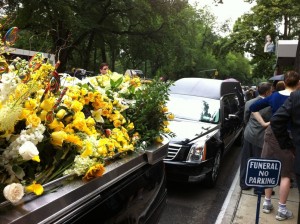Kiss the Man Goodbye: Marvin Hamlisch and his Memorial
To anyone in the theater, music, or movie businesses, the passing of Marvin Hamlisch was an earthquake that caused everyone who knows his name to pause in shock. A winner of Emmy, Grammy, Oscar, Tony, Golden Globe, and Pulitzer awards, Marvin was a gentle giant of composition. It was because of all this that I was humbly thrilled to have been invited by musical director and conductor of Essential Voices USA, Judith Clurman, to sing at his memorial this past Tuesday morning. It was a star-studded event that proved to be less about the people in the temple, but more about Marvin’s genius, his love of laughter and humanity, and his music. Read the New York Times article if you want to know who was there and some of what was said.
I was one of six hundred people who gathered at the Temple Emanu-El on East 66th Street (the same temple that George Gershwin was memorialized in, and I could not help but sense a moment in history, sitting in that space on that morning). We all wore black and had three songs in our binders to rehearse. We rehearsed filing in and out of the guilded and gloriously high-ceilinged inner sanctuary, rehearsed with the conductor and piano, went through a song with Broadway star Idina Menzel, and then took a very quick break. No cell phones or water were allowed when we returned to the sanctuary. When we filed in again, the center was filled with people except for the first two rows. I sat towards the front (about 10 rows back) and on the lefthand side facing the…uh…whatever the Jewish equivalent of the Altar is, near the piano and solo spot, but towards the opposite side of the main speaker’s pulpit.
Hamlich’s casket was up on the main area, bursting in yellow flowers (the top almost completely covered by them). As we waited, we saw that VIPs and family members were arriving. Passing in front of me, I saw President Bill Clinton and Liza Minelli, as well as actress Julie Hagarty from Airplane!. But I knew the place was filled with political, theater, and movie stars, as well as people from around the world who had a personal or professional connection to him and his music. While I’m not a dancer, and never considered A Chorus Line ever to be a part of my repertoire, Marvin Hamlisch’s music has permeated my life and has woven its way into my psyche. Which is why I was so happy that the loving speeches (which made up 3/4 of the hour and a half long memorial) were so terrifically spoken, portraying a wonderful sprite of a man. I was honestly never more entertained by eulogies before! When described, he seemed to rise above the pettiness of everyday life – he was always musical, always trying to help strangers and friends, and had a lust for life and the humor in it. The speeches were touching and hilarious – so many personal jokes were regaled about Marvin and how he made people laugh, and I found the same number of laughs coming out of my mouth as were lumps in my throat. Maybe more, even.
The Rabbi (I unfortunately don’t know his name, but he was a family friend) spoke about the sadness he felt that Marvin was taken before he had the chance to finish the things he had planned for the future. He quoted from Ecclesiastes 9:11: “I returned, and saw under the sun, that the race is not to the swift, nor the battle to the strong, neither yet bread to the wise, nor yet riches to men of understanding, nor yet favour to men of skill; but time and chance happeneth to them all.” It spoke volumes to me that life cannot be fair, even to someone as hard-working and giving as Hamlisch. The Rabbi also quoted a beautiful poem “After My Death” by Hayyim Nahman Bialik, who wrote of the melodies and songs that would be lost at the event of his own passing. Friends and family members spoke one after the other, including President Bill Clinton and Hamlisch’s wife, Terry.
It was Terry’s eulogy that got us all wrecked. She spoke of how he never said “no” to anyone, was always eager to jump in to any project or good deed, how he kept her laughing by singing an entire musical on their bed late at night, how he loved music and the future of music by teaching students for free, and how he went by “Marvin” and refused to consider himself above anyone else. By that time, we had sung “The Way We Were” in five-part harmony (600 voices, plus those who sang from the main audience), was a stunning thing to hear even from within the wall of sound. We did so full-voiced and proud. However, after Terry spoke and we all watched as she walked to the coffin and placed her hand on it to say goodbye, there couldn’t have been a dry eye or lump-less throat in the audience or the singers. So, we were forced to stand, lift our music up, and sing “What I Did For Love” in quivering tones. I can’t remember the last time it was that hard for me to sing through an emotion, a TRUE emotion and not just “acting” tears. We were able to take a breath and swallow our vocal lumps as Idina sang the verse of “At The Ballet,” then join her a little stronger at the choruses. We all watched as the coffin was carried down the aisle and the family and friends exited after. When we returned to our break room, we were all muted, red-eyed, and contemplatively quiet. I took a moment to sign the poster that was made for the Hamlisch family on behalf of the singers (I saw Craig Carnelia’s name under mine as I signed, go figure!), and then went out the door to see the front entrance of the temple surrounded by media and mourners.
The hearse was there, parked in front of the temple’s entrance, as well as the lead-car. The lead car was ablaze with more yellow flowers, only this time it also included rainbow-colored lollipops (assumably to reflect “Sunshine, Lollipops and Rainbows,” a famous song by Hamlisch that reveals more about his personal character than anything else). I watched as the lead car and hearse drove away, then went off on my own way, happy to have said goodbye in person. I also reflected that a person can matter a lot to both a King and the Common Man, as long as he or she is always striving to do good and create amazing, beautiful, heartfelt, and important work. It didn’t matter how famous you were in that temple – everyone who cares about music lost a great creative friend of the arts this month.
Some pictures I took outside of the temple (click on an image for a bigger, clearer version):



